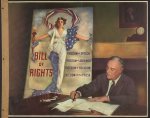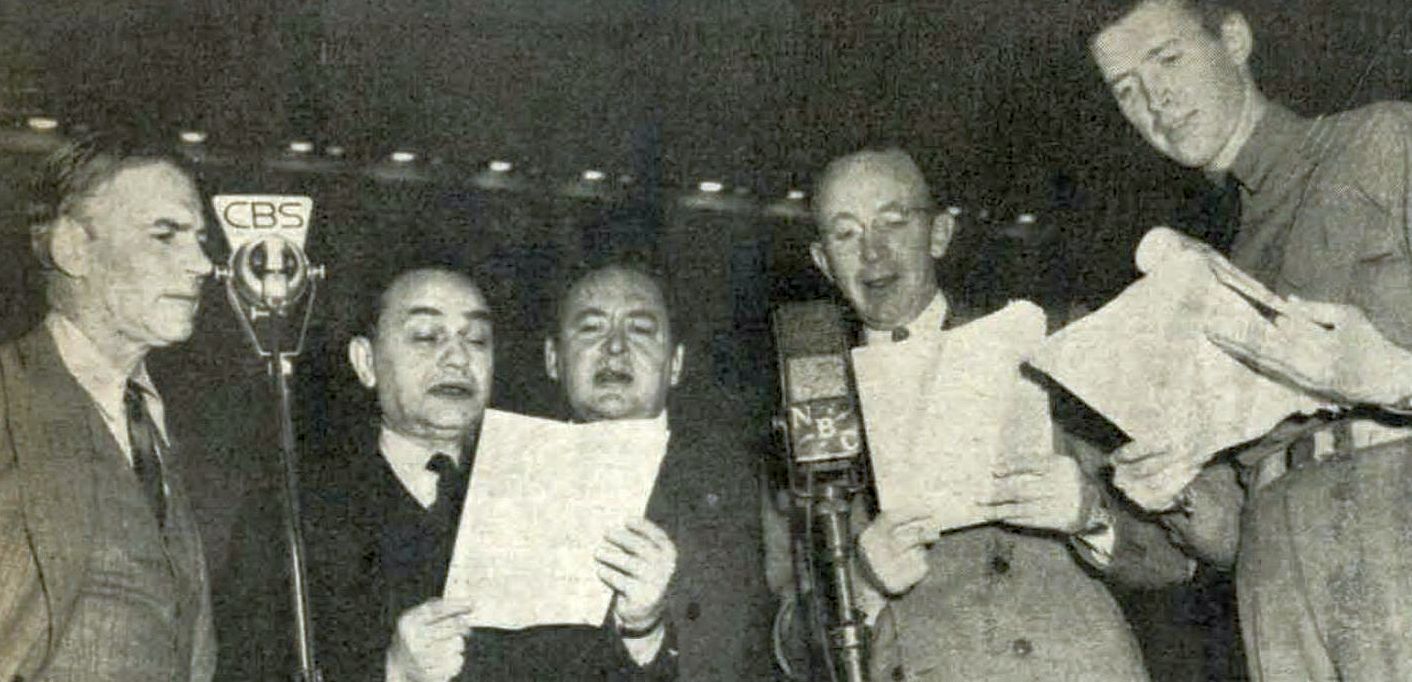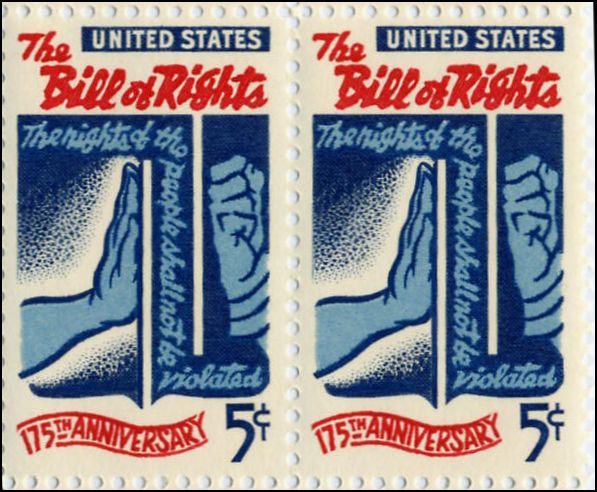The first ten amendments prevent majorities from exercising power at the expense of individuals. But they weren’t called a “bill of rights” until more than a century after ratification.
-
Winter 2020
Volume64Issue1
On December 15, 1941, America was at war. Just one week earlier, President Franklin D. Roosevelt warned the nation that “our people, our territories, and our interests are in grave danger” after the “unprovoked and dastardly attack by Japan” on Pearl Harbor. Three days after that, Adolf Hitler addressed the Reichstag and said that Nazi Germany must defend itself against President Roosevelt’s aim of establishing “world domination and dictatorship.”

By an accident of fate, these dizzying events came right before the one hundred and fiftieth anniversary of the ratification of the first ten constitutional amendments — the American Bill of Rights. Among these provisions are the First Amendment, which protects the freedom of speech and free exercise of religion while barring an establishment of religion.
The Second Amendment provides: “A well regulated Militia, being necessary to the security of a free State, the right of the people to keep and bear Arms, shall not be infringed.” The Third Amendment restricts the government’s power to quarter soldiers in private homes, and the Fourth Amendment prohibits “unreasonable searches and seizures.” Due process of law is guaranteed in the Fifth Amendment, along with the right to just compensation if property is taken for public use. Criminal defendants may not be convicted without following the procedures in the Sixth Amendment, including the right to a jury trial and the ability to cross-examine witnesses. The Seventh Amendment secures the right to a civil jury trial, while the Eighth Amendment bars “cruel and unusual punishments.” Through the Fourteenth Amendment and Supreme Court decisions, most of these liberties were extended to the actions of state governments as well as the Federal Government.
Across the country, children recited the Bill of Rights in public schools and people from all walks of life came out to show their support for their fundamental liberties, including freedom of speech, the free exercise of religion, the right to bear arms, freedom from unreasonable searches and seizures by the police, the right to just compensation when property is taken for public use and the right to jury trial.
This national festival ended in a distinctly American way — with a prime-time drama on the Bill of Rights performed by Hollywood celebrities. Called “We Hold These Truths,” the hour-long show was broadcast over all four national radio networks and was heard by an estimated 63 million people, which was almost half of the entire population. Lionel Barrymore stated that the program was about “a document that men have fought for, that men are fighting for, that men will keep on fighting for as long as freedom is a strong word falling sweet upon the ear.”
Orson Welles, fresh off the release of Citizen Kane, narrated the next scene and gave way to Jimmy Stewart, who took the audience back to the debate over the Constitution’s ratification, in which one of the most important disputes was that the proposal did not have a bill of rights.
Eventually, Stewart said, “the people were promised changes, promised amendments, promised that their freedoms should be written down in black and white for all to see, for all to know, for all to live and prosper by.” The First Congress hammered out those rights with memories of “all the tyrants and the martyrs who had gone before.” The result was “a ten-part epic of amendments,” which was then read in its entirety by a star-studded cast.

The final part of “We Hold These Truths” was turned over to the most popular radio star in the land: President Franklin D. Roosevelt. “Free Americans,” he began, “No date in the long history of freedom means more to liberty loving men in all liberty-loving countries than the fifteenth day of December 1791. On that day, 150 years ago, a new Nation, through an elected Congress, adopted a declaration of human rights which has influenced the thinking of all mankind.”
“There is not a single Republic of this hemisphere,” Roosevelt said, “which has not adopted in its fundamental law the basic principles of freedom of man and freedom of mind enacted in the American Bill of Rights. There is not a country, large or small, on this continent and in this world, which has not felt the influence of that document, directly or indirectly.”
“Indeed, prior to the year 1933, the essential validity of the American Bill of Rights was accepted everywhere at least in principle. But in that year 1933,” the President continued, “there came to power in Germany a political clique which did not accept the declarations of the American bill of human rights as valid: a small clique of ambitious and unscrupulous politicians whose announced and admitted platform was precisely the destruction of the rights that instrument declared.”
“The entire program and goal of these political and moral tigers,” he explained, “was nothing more than that overthrow, throughout the earth, of the great revolution of human liberty of which our American Bill of Rights is the mother charter.” “We will not,” FDR concluded, “under any threat, or in the face of any danger, surrender the guarantees of liberty our forefathers framed for us in our Bill of Rights.”

The praise heaped on the Bill of Rights at the start of World War II is entirely consistent with the importance of the document that is now displayed under glass at the National Archives alongside the Declaration of Independence and the Constitution. A bill of rights was barely mentioned at the Constitutional Convention, but its absence was the leading criticism of the proposal when the debate moved to the state ratifying conventions.
In some states, the Federalists prevailed only after making an informal promise to the Anti-Federalists that the Constitution would be amended as soon as possible to include a bill of rights comparable to the English Bill of Rights of 1689 or the bills of rights in some of the state constitutions. As Justice Robert H. Jackson once wrote: “Without promise of a limiting Bill of Rights it is doubtful if our Constitution could have mustered enough strength to enable its ratification.”
Why, then, was the first Bill of Rights Day not held until 1941? The answer to that question challenges what most Americans think they know about their Bill of Rights. It turns out that for more than a century after the first ten amendments were ratified in 1791, hardly anyone called them a bill of rights, let alone the Bill of Rights. For example, James Madison, who drafted them, never described what the states ratified as the Bill of Rights.
When Chief Justice John Marshall, who wrote the Supreme Court’s landmark opinion in Marbury v. Madison, discussed a national bill of rights, he talked about parts of Article One, Sections Nine or Ten, of the Constitution—not about the first ten amendments. And as late as 1880, Justice Samuel F. Miller declared: “Our Constitution, unlike most modern ones, does not contain any formal declaration or bill of rights.”
In short, during the nineteenth century, most people simply did not think that the country had a national bill of rights or that the first set of constitutional amendments were special. The bills of rights that mattered during this era were in state constitutions, especially Virginia’s Declaration of Rights of 1776, and new states looked to those bills of rights as models instead.
When Americans did discuss their bill of rights, they disagreed sharply about what that was. Some felt that the Declaration of Independence was the Bill of Rights. Others said that Section One of the Fourteenth Amendment was in the Bill of Rights. And many argued that only the first eight or the first nine constitutional amendments should be considered the Bill of Rights. The debate on this last issue, which started following the Civil War and lasted until the 1960s, reveals how lawyers and politicians grappled with the concepts of unwritten rights (embodied by the Ninth Amendment) and states’ rights (found in the Tenth Amendment) by arguing for their inclusion or exclusion from the Bill of Rights.
The belief that the first ten amendments are the Bill of Rights did not become dominant until the twentieth century, and one reason for that change is as astonishing as the fact that the change took so long to happen. When modern Americans think of the Bill of Rights, the first thing that comes to mind is that these amendments were designed to limit government.
As the Supreme Court stated in 1943: “The very purpose of a Bill of Rights was to withdraw certain subjects from the vicissitudes of political controversy, to place them beyond the reach of majorities and officials and to establish them as legal principles to be applied by the courts. One’s right to life, liberty, and property, to free speech, a free press, freedom of worship and assembly, and other fundamental rights may not be submitted to vote; they depend on the outcome of no elections.”
Although this libertarian rationale for bills of rights was given during the Founding, some supporters and opponents of the Constitution contended that adding a bill of rights was a mistake that would give people a false sense of security and serve only to legitimate the growth of government power, in part by convincing voters to support ratification of the Constitution with its stronger national institutions.
Sure enough, in the first half of the twentieth century, the Bill of Rights was invoked more frequently to justify a stronger national government at home and abroad. When the United States acquired the Philippines after the Spanish-American War, the constitutional legitimacy of ruling that foreign land was in doubt until the islands were given what the Supreme Court described as the “Philippine Bill of Rights” based on portions of the first ten amendments.
Three and a half decades later, when a flood of federal regulations under the New Deal was attacked as dangerous to liberty, President Roosevelt said that the charge was false because the Bill of Rights remained unaffected and those were the freedoms that mattered. And when FDR sought to expand the New Deal in 1944 to include new entitlements such as health care, education, housing, and jobs, that set of reforms was presented to the country as a ‘‘Second Bill of Rights” and was a major influence on the Universal Declaration of Human Rights issued subsequently by the United Nations. In all of these cases, the Bill of Rights symbolically validated new legislative and executive action, just as the text did for the extraordinary powers exercised by the federal government during World War II, including a military draft and the rationing of basic necessities.
Only after the start of the Cold War in the late 1940s did the Bill of Rights settle into its familiar role as a text that prevents majorities from exercising power at the expense of individual rights. When an original parchment of the congressional proposal that became the Bill of Rights was finally put on display in the National Archives in 1952, President Harry Truman stated: “I am glad that the Bill of Rights is at last to be exhibited side by side with the Constitution. These two original documents have been separated for too long. In my opinion, the Bill of Rights is the most important part of the Constitution of the United States--the only document in the world that protects the citizen against his government.”
Truman acknowledged that “there are dangers in religious freedom and freedom of opinion. But to deny these rights is worse than dangerous, it is absolutely fatal to liberty. The external threat to liberty [from the Soviet Union] should not drive us into suppressing liberty at home.”
The Bill of Rights is a mirror for how America sees itself. E Pluribus Unum, “One Out of Many,” represents America’s diversity as its strength. Many individual portions of the Bill of Rights, such as the First Amendment, are stars in their own right, but together they form a unique group. They are, in Justice Hugo L Black’s words, “the heart of the Constitution.”
Portions of this essay were adopted by the author from his recent book, “The Heart of the Constitution: How the Bill of Rights Became the Bill of Rights,” Oxford University Press, published in 2018.

